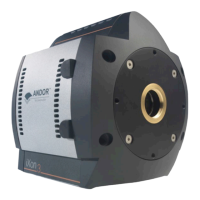Page 36
Features & Functionality
3.4.2.1 - Points to note about using an FT CCD as a standard CCD
• Theexposuretime,accumulationcycletimeandthekineticcycletimeareindependent.
• Theminimumexposuretimeisnotrelatedtothetimetakentoreadouttheimage.
• ExternaltriggeroperatesasiftheCCDwasanNFTCCD.
• AsthecapturedimageisquicklyshiftedintotheStoragearea,eveninNFTmode,thesystemcanstillbeused
without a mechanical shutter.
• ForshortexposuretimestheimagemayappearstreakedasthetimetakentoshifttheImageareaintothe
Storage area and the exposure time may be of similar magnitude, but much less than a ral non-frame transfer.
• LightfallingontheImageareawhiletheStorageareaisbeingreadoutmaycontaminatetheimageinthe
Storage area due to charge spilling vertically along a column from the Image area. The slower the read-out rate
or the shorter the exposure time the greater the possibility of corruption. To see why this is the case consider
the following situation:
“During a 100us exposure enough light has fallen on a pixel to register 10000 counts, or 100,000 electrons
assuming 10e/count. The image is then shifted into the Storage area. To read out the image, assuming
1000x1000 pixels, it would take approximately 100ms at 10MHz readout rate. This means that during the reading
out of the image 10 million counts (10000 * 1000) will have been acquired into the pixel described above. As a
pixel saturates at approximately 160,000 electrons this means that the pixel will over saturated by 60 times. All
the excess charge has to go somewhere, and spreads vertically along the CCD column. As the clocks in the
Image area are not actively shifting the charge, the mobility of the charge will be low and you may not see any
effect. However, when you consider that more than one pixel in any given column could be exposed to 10000
counts per 100μs. The chance of corrupting data is correspondingly increased. Reducing the amount of light
falling on the CCD outside of the exposure period and increasing the exposure time accordingly will reduce the
possibility of data corruption”.

